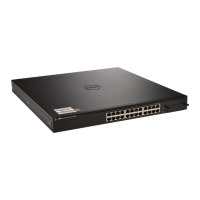Configuring Data Center Bridging Features 819
DCBX information is carried over LLDP, which is a link-local protocol. When
configuring links in a port channel to use DCBX, the DCBX settings should
be the same for all links in the port channel.
Interoperability with IEEE DCBx
To be interoperable with legacy industry implementations of the DCBx
protocol, The PowerConnect 8024/8024F/81xx switches use a hybrid model
to support both the IEEE version of DCBx (IEEE 802.1Qaz) and legacy
DCBx versions.
The PowerConnect 8024/8024F/81xx switch automatically detects whether a
peer is operating with either of the two CEE DCBx versions or the IEEE
standard DCBx version (the default mode). You can also configure DCBx to
manually select one of the legacy versions or IEEE standard mode. In auto-
detect mode, the switch starts operating in IEEE DCBx mode on a port, and
if it detects a legacy DCBx device based on the OUI of the organization TLV,
then the switch changes its DCBx mode on that port to support the version
detected. There is no timeout mechanism to move back to IEEE mode. If the
DCBx peer times out, multiple peers are detected, the link is reset (link
down/up) or if commanded by the operator, DCBx resets its operational mode
to IEEE.
The interaction between the DCBx component and other components
remains the same irrespective of the operational mode it is executing. For
instance, the DCBx component interacts with PFC to get needed
information to pack the TLVs to be sent out on the interface. Based on the
operational control mode of the port, DCBx packs it in the proper frame
format.
DCBx and Port Roles
The behavior of each port is dependent on its operational mode and that of
other ports in the stack. The port mode is a DCBx configuration item that is
passed to the DCBx clients to control the processing of their configuration
information. There are four port roles:
1
Manual
2
Auto-Upstream
3
Auto-Downstream
4
Configuration Source

